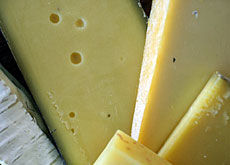According to the American Heritage dictionary, the definition of funny is "causing laughter or amusement."
Just the other day Chase was watching Dagney, our cat. Dagney stepped onto a piece of tape, which stuck to her paw. Dagney looked utterly dismayed. When she lifted her paw the piece of tape hung from it. Chase burst out laughing. She laughed and laughed.
I couldn't help but ask myself the question: How did she know it was funny?
In an attempt to answer this, we first have to answer the question: What is a sense of humor? The National Association of School Psychologists reports that there is actually a two-part answer. First, there is a mental ability to discover and appreciate events that are humorous. Second, situations that surprise have the potential to create laughter.
They go on to say that in terms of development, a caretaker's voice or tactile stimulation can cause a smile to occur from a fully alert baby at one month. Smiles associated with recognition of faces take place by the fourth month. "Peek-a-boo" should create laughter by the eighth month.
Parents who show silly behavior (e.g., pretending to drink from the baby bottle) can produce laughter by the first birthday. They indicate that a sense of humor begins to develop in the second year, when the child can engage in fantasy or make-believe behavior.
So my question remains. How did she know it was funny?
Special thanks to http://www.amphi.com/~psych/humor.html for facts above..
Wednesday, September 06, 2006
Things I love about Switzerland: Cheese

I must salute a country isn't afraid to serve up big pots of melted cheese (otherwise known as fondue) with bread and potatoes (when we ask for veggies, they look at us like we were crazy).
As my own cheese consumption has easily tripled since moving to Switzerland, I found myself wondering how much cheese the Swiss consumed on an annual basis (could my consumption be normal?). After doing a little research, I discovered that last year, the Swiss ate 149,991 tons or 19.74kg (43.52 lbs!) per person (good, sounds like I'm right on track). Not surprising, given that there are about 450 kinds of cheese produced in Switzerland (so much cheese; so little time).
At this point, I feel I must take a moment to dispel a myth: most Swiss cheese doesn't have holes. What we (Americans) call "Swiss cheese" is in fact Emmentaler (the holes are caused by carbon dioxide building up as it matures - the process gives it its taste). You may or may not be surprised to know that what is marketed in the US as "Swiss cheese" or "Emmentaler cheese" was, most likely, produced in Wisconsin, Utah and Ohio.
So what are some typical Swiss cheeses?
- Emmentaler: Discussed above.
- Gruyere: Produced mainly in French-speaking Switzerland and is claimed by both Switzerland and France (typical). This cheese is used in fondues and French onion soup (I love it in quiche).
- Appenzeller: A semi-hard cheese, named from the region from which it comes. While it is curing, it is washed with an herbal brine, which gives the cheese a fruity flavor.
- Raclette: My favorite. Raclette, the dish, is prepared by heating the cheese and scraping it onto a plate. Yes, that's right. Melted cheese on a plate. Deee-lish. It is most often accompanied by small potatoes and gherkins.
A quick cheese factoid: US President Clinton horrified the Swiss when, in one of the final acts of his administration, he agreed to a recommendation that the size of the holes could be halved (slow day at the White House?) The reason: to reduce the chances of the cheese bursting and to make it easier to slice. Swiss manufacturers quickly announced that the plan did not affect them (and most likely made sure Clinton would never be allowed entry into Switzerland).
... Oh my darling Chase, if only your little tummy could handle cheese ...
Special thanks to swissworld.org, swissinfo.org and senselist.com for valuable cheese factoids and figures
Subscribe to:
Comments (Atom)